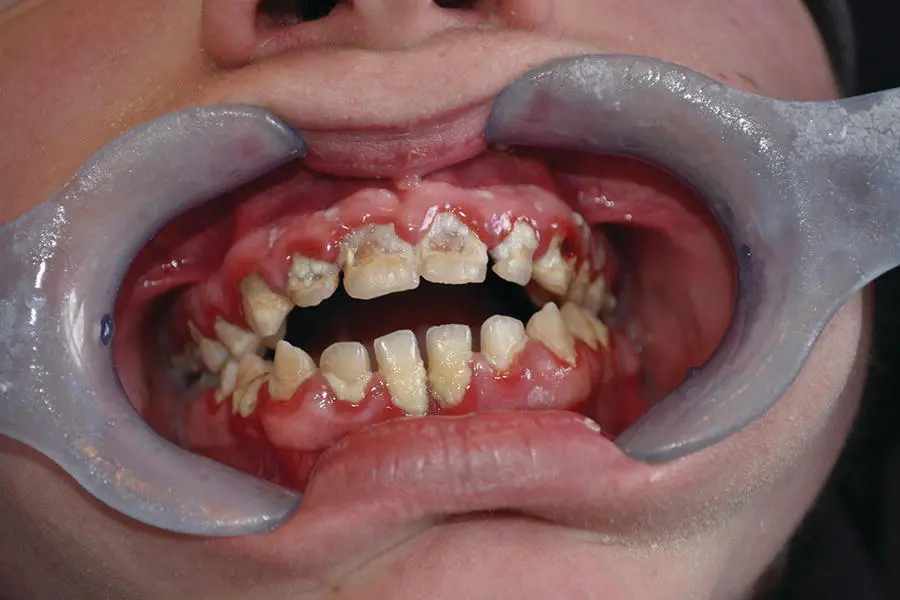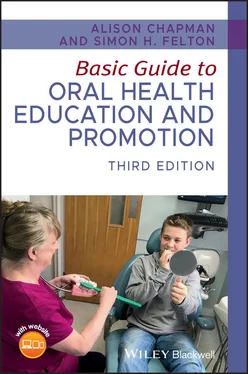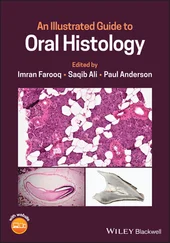1 ...6 7 8 10 11 12 ...15 6 6. Lindhe, J., Karring, T. & Araújo, M. Anatomy of the periodontium. In: Clinical Periodontology and Implant Dentistry (eds. J.T. Lindhe, T. Karring & N.P. Lang). 4th edn, pp. 3–49. Blackwell Munksgaard, Oxford.
7 7. Collins, W.J., Walsh, T. & Figures, K. (1999) A Handbook for Dental Hygienists. 4th edn. Butterworth Heinemann, Oxford.
8 8. Fejerskov, O. & Kidd, E. (2003) Dental Caries: The Disease and its Clinical Management. Blackwell Munksgaard, Oxford.
Section 2 Diseases and Conditions of the Oral Cavity
INTRODUCTION
This section explores the reasons for, and the effects of, the breakdown of oral health, and details advice that should be given to patients to control disease and restore a good standard of oral health.
What causes oral disease?
There is, of course, no brief answer. The determinants are many and complex, and more often than not a combination of factors is involved in the development of a particular condition or disease: genetic, cultural, environmental, socioeconomic, diet, and lifestyle.
Education is vital in controlling dental disease, and that is where the oral health educator (OHE) can help.
Chapter 2 Plaque, calculus, and staining
Learning outcomes
By the end of this chapter you should be able to:
1 Explain the causes and development of plaque, and advise on plaque control.
2 Distinguish between aerobic and anaerobic bacteria and their effects on oral tissues.
3 List secondary factors in the development of plaque.
4 Explain the types, causes and effects of calculus, and its treatment.
5 Differentiate between intrinsic and extrinsic tooth staining, their causes and treatment (including whitening).
Oral health educators (OHEs) need an understanding of plaque and calculus, and their roles in the development of common dental diseases, such as caries, gingivitis, and periodontitis. The OHE should also be able to distinguish between intrinsic and extrinsic staining, and answer patient questions on teeth whitening.
Most people have heard of plaque, but few would be able to explain its composition.
Plaque is a soft, non‐calcified adherent film that collects on the surfaces of teeth, and comprises approximately:
70% microorganisms (bacteria, fungi, viruses).
30% matrix (the framework that holds it together).
Plaque is found in all mouths and makes up part of the natural flora of the body. The most common sites where plaque is found are occlusal pits and fissures, cervical margins of the teeth and in periodontal pockets. Patients can be made aware of plaque in their mouths by using a disclosing solution or tablets ( Figure 2.1a,b). (See Chapter 19.)
Plaque is a major causative factor in gingival and periodontal disease and a contributory factor in dental caries. Even in people with good toothbrushing skills, one would need to brush and floss approximately every 3 minutes in order to prevent plaque from forming.

Figure 2.1 (a,b)Plaque undisclosed (a) disclosed (b) in the same mouth.
Source: Alison Chapman.

Figure 2.2 Mature plaque and gingivitis in a neglected mouth.
Source: Alison Chapman.
In a healthy mouth, there is a natural balance of bacteria, but when illness or antibiotics (for example) upset the balance of the mouth’s flora, or when teeth are not cleaned often and/or appropriately, plaque matures. Waste products from the bacteria, enzymes and toxins then cause an inflammatory response in the gingival tissues leading to gingivitis ( Figure 2.2). Depending on an individual’s response, gingivitis can progress to periodontal disease.
Dental plaque is a type of biofilm , and the concept of a biofilm is of huge importance not only to dentistry, but also to the wider medical world and many sectors of industry. Since the 1990s, there has been a huge amount of research into biofilms, which reflects our growing understanding of their importance.
A biofilm , in simple terms, is a thin layer of bacteria that adheres to a surface. Over 95% of bacteria in nature exist in a biofilm state as opposed to living independently, and over 500 species of bacteria have been identified in oral plaque biofilms. Contact lenses, rocks in rivers and aspirator tubing in the dental surgery are all examples of surfaces colonised by biofilms.
Within a biofilm, bacteria are not just sitting alongside one another passively; they are communicating, interacting, and gaining benefits from one another – acting as a team. This is what makes a biofilm so virulent, resilient, and difficult to manage.
Bacteria is the most common microorganism found in the plaque biofilm, and can be classified as to whether they need oxygen (aerobic) or not (anaerobic) to survive.
The majority of bacteria in a healthy mouth come from the oxygen‐dependent (aerobic) streptococci genus, which colonise areas of the mouth where oxygen is readily available. When resistance is lowered, they can give rise to sore throats and other illnesses, but are generally less potentially harmful than their non‐oxygen‐dependent (anaerobic) relatives.
The most common species of streptococci bacteria found in the oral cavity are:
Streptococcus sanguis.
Streptococcus mutans.
Streptococcus mitis.
Streptococcus salivarius.
Aerobic bacteria feed on sucrose from the human diet and produce sticky substances that enable other more harmful organisms to attach themselves, causing plaque to become more dense and harmful to tissues.
Anaerobic bacteria are a more potentially pathogenic (disease causing) bacteria, when displaced from their normal habitat. They produce enzymes and toxins and do not need oxygen to survive. They can be found in deeper layers of plaque and in areas of the mouth, such as periodontal pockets, which render them difficult to remove. Examples of anaerobic bacteria are:
Fusiforms.
Vibrios.
Spirochaetes.
Other microorganisms found in plaque
As well as bacteria, other microorganisms found in plaque, include fungi and viruses.
Fungi, such as Candida albicans, are also commonly found in plaque. As with bacteria, these do not affect oral health unless the body’s resistance is lowered and the immune system is upset, in which case they can cause dental thrush or stomatitis (see Chapter 8).
The most common virus in the oral cavity is herpes simplex, which gives rise to cold sores (see Chapter 8).
In addition to providing an abundant food source for bacteria, plaque also collects other debris present in the mouth, which forms the matrix (in which the colonising bacteria feed and reproduce).
The following substances make up the matrix:
Proteins and carbohydrates (from food debris).
Dead cells (from oral tissues).
Red blood cells.
White blood cells.
Antigens (involved in the body’s immune response).
Читать дальше














